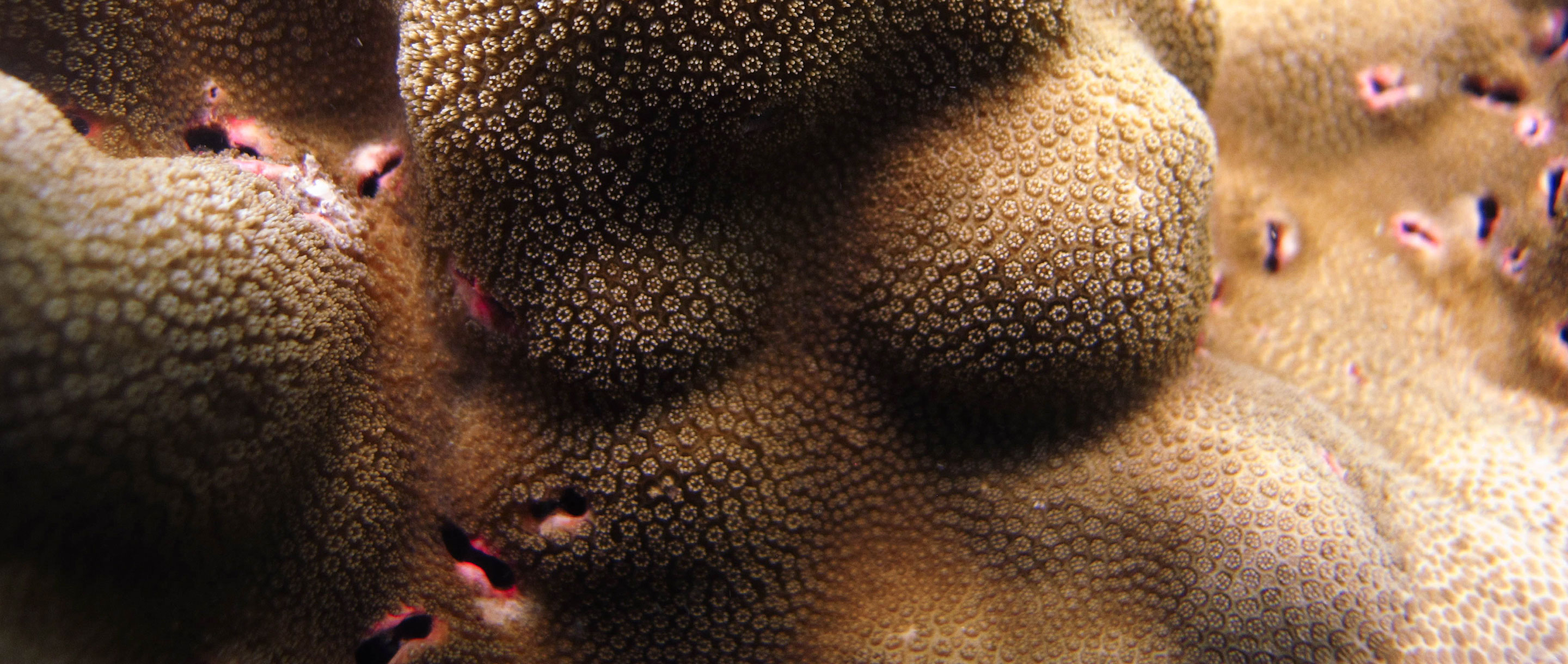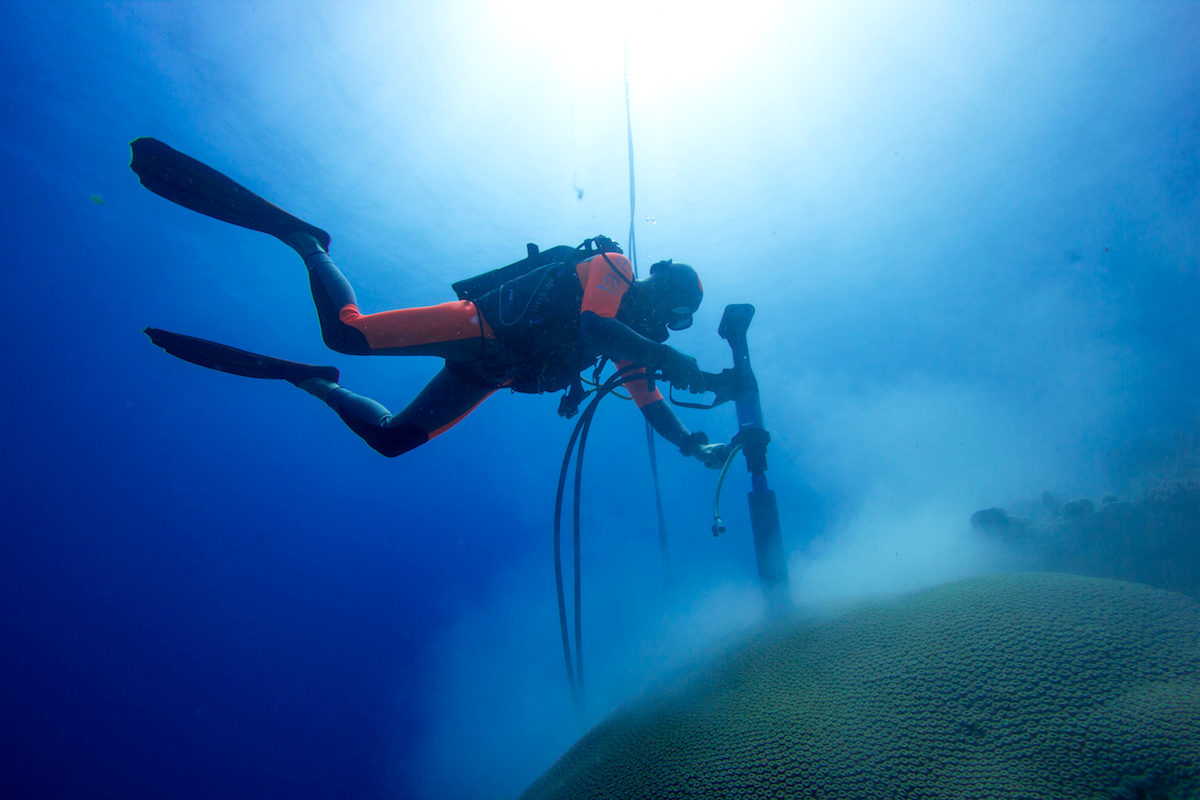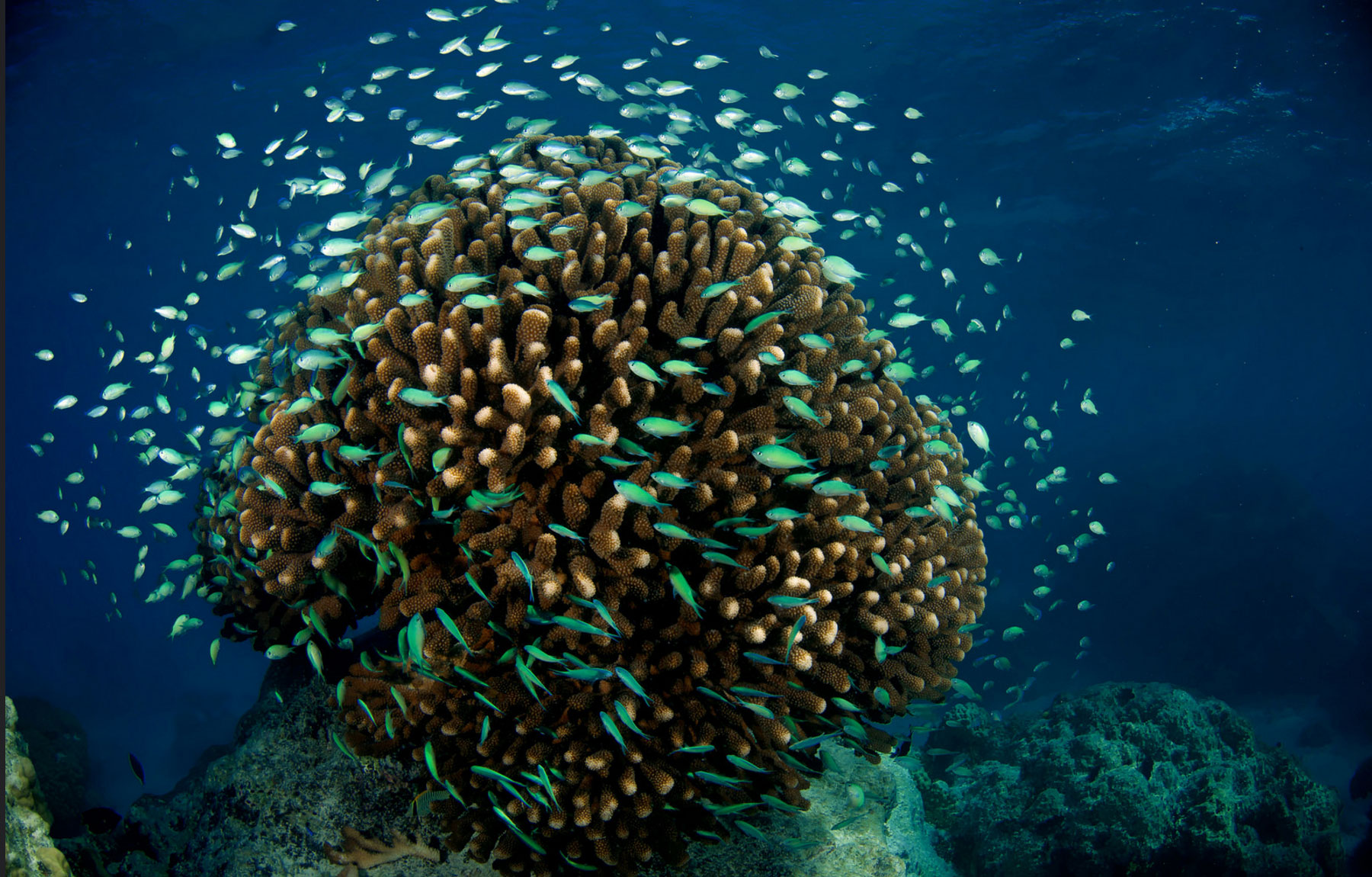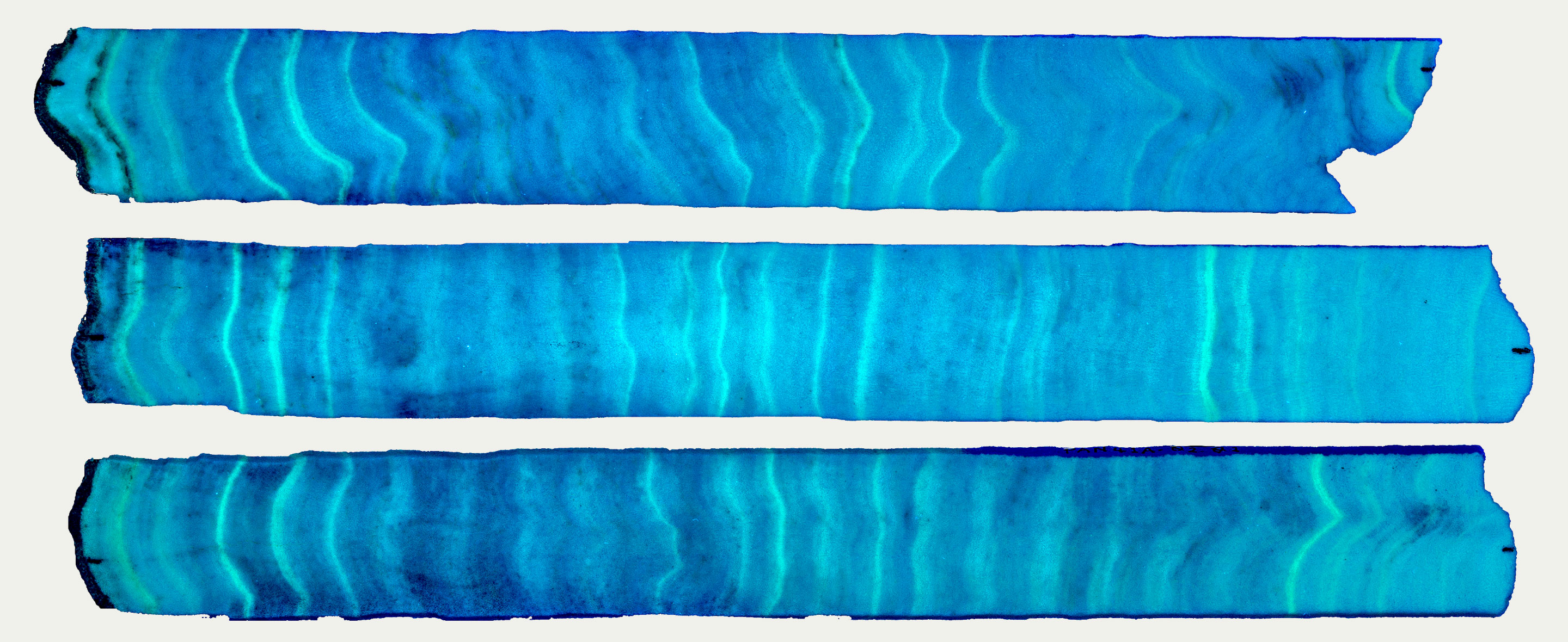Cores From Coral Reefs Hold Secrets of the Seas’ Past and Future
Introduction
As the sun dims over the Pacific’s glassy Solomon Sea, Guillaume Iwankow dons his diving gear and descends from the research schooner Tara into a motorized dinghy. His goal is to bring back a core, an arm’s-length sample of a coral colony that chronicles decades of its lifetime.
About 10 minutes after the dinghy leaves Tara, its motor slows. It’s so shallow here that reef fish dart about just inches from the surface. Iwankow, a scientific dive master for the Tara Expeditions Foundation, is looking over the coral for the biggest, most pristine example he can find of Porites lobata — a round, yellow-green coral species that often grows so large that it looks like the contents of Godzilla’s cranium. Coral colonies are made up of soft-bodied animals called polyps, which (with the help of symbiotic algae) secrete thin layers of the mineral calcium carbonate. Over time, these annual layers accumulate one atop another in a hard mass that makes up the coral skeleton.
Once he’s located the ideal Porites, Iwankow presses the three-inch-wide circular blade of his coring tool into the surface of the coral. There’s a faint whirring noise as the blade sinks into the skeleton, and clouds of coral dust billow in the surrounding water. After penetrating through all the coral layers, Iwankow taps the corer’s barrel this way, then that, to dislodge the base of the sample he’s cut, which is typically about a foot and a half long. He repeats that process twice more through the same hole, then swims back up and deposits the lengths of core sample —about four feet long in their entirety — in the dinghy. Only the surface of the Porites formation contains live polyps, so after drilling, the coral formation should continue to grow in the shallows, unharmed and without interruption.
Marine science expeditions like this one collect all kinds of biological samples, from ocean water to reef fish to coral microbes. But coral cores are distinct from the rest. They are organic time capsules, containing records of local pollution, geology, temperature and reef health that go back hundreds or thousands of years. As researchers refine the surprising methods available to extract this kind of information from coral skeletons, the advice for climatologists, geochemists and paleontologists who want to plumb the oceans’ past has increasingly become: Look to the cores. “I call them natural reef history books,” said Janice Lough, a climatologist and coral core expert at the Australian Institute of Marine Science. “They’ve got lots of stories to tell.”
Drilling Into Ocean History
Like forensic detective work, coral coring has become a reliable way to add detail and credibility to theories about past events — or to prove that they happened at all. It’s easy to forget that no one was even sure corals set down annual growth rings until the 1970s. That was when a team of University of Hawaii geophysicists visited Enewetak Atoll in the South Pacific.
Enewetak was an unassuming island with an unusual history: The United States tested nuclear bombs there on various dates in the 1940s and ’50s. The Hawaii researchers were curious to see whether coral skeletons near Enewetak would show evidence of this radioactivity. If the coral core layers contained radioactive elements with a known half-life, it would be possible to calculate almost exactly when each growth ring was made. “They took a slice of a massive colony, put it on [light-]sensitive paper in a darkroom for a month, and they saw a series of radioactive bands,” Lough said. The spacing of the bands on the paper hinted that there might be more to discover within the hidden structure of the coral, suggesting a further test was in order. “They got in touch with the local doctor and said, ‘Would you mind X-raying our coral slice?’”
When the coral slices were put in the X-ray scanner, a distinctive series of light and dark growth rings became visible, reflecting the density of the calcium carbonate that made up the coral skeleton. Dating the radioactive elements in the skeleton revealed that a double set of rings was laid down each year: a larger, more porous ring and a narrower, denser ring. In a 1972 Science paper, the researchers dubbed the cores “coral chronometers,” alluding to their utility as natural timepieces. Other scientists have since reported that corals lay down larger growth rings during wet seasons when temperatures are more moderate, and smaller rings during dry seasons when conditions are more extreme.
Coral species grow between 0.3 and 10 centimeters per year, but a general rule of thumb is that a 100-centimeter-long core sample, for instance, supplies a record of about 100 years of that coral’s history. Often it is the most recent 100 years, but not always. Fossilized corals may contain sequences of growth rings that date back as far as the last interglacial period, more than 100,000 years ago. X-ray scans are still used today to assess the relative density of coral growth rings, which reflects the climatic conditions at the time the rings were created. But marine scientists have worked steadily to discover the significance of other coral core properties as well.
One of the richest stores of data inside a core, coral detectives are finding, is its year-by-year record of trace elements in ocean water. Coral polyps take in ocean water to extract minerals they need to build their skeletons, so each carbonate layer contains tiny amounts of whatever was in the water when the layer was created. While coral growth rings are “not as nice and tight as tree rings, due to the complex internal shape of the skeleton,” said Gregory Webb, a University of Queensland paleontologist, “they do record the chemistry of the water they grow in.”
Tests of coral core composition, therefore, allow scientists to chart levels of many different compounds in an ocean zone from one year to the next. This can yield insights into planetary processes that seem to have little to do with coral. Marine scientists at China’s Guangxi Key Laboratory recently deduced the strength of East Asian winter monsoons over the past 150 years by measuring levels of rare earth elements, such as lanthanum and cerium, in each layer of a Porites coral core. These rare earth elements come from swirls of dust deposited during the winter storms, so the elements’ prevalence is a reliable gauge of storm intensity.

This close-up photo of Porites lobata shows the tiny clusters of protruding tentacles on the coral polyps. These animals secrete calcium carbonate skeletons around themselves and create the reef with the help of symbiotic algae.
Likewise, coral core tests are uncovering historical evidence of human-caused pollution that is far more detailed than any found before. Lough and her colleagues are sampling modern cores from the Great Barrier Reef and testing growth layers for levels of toxic metals such as lead and cadmium, which often come from industrial production. Developers might build a port, dump sediment onto a coral reef, and insist their intervention has no effect on the ocean — but, as Lough pointed out, “the coral cores are unbiased observers of how the environment is changing.”
Coral cores also supply some of the only reliable records of ocean temperatures during the years before official measurements were taken. When waters are cooler, corals use more of the element strontium to supplement the calcium carbonate they use to build their skeletons. By calculating the ratio of calcium to strontium in each layer of a coral core, researchers can determine what the ocean temperature was when that layer was created.
Using this technique on coral cores from the tropical Pacific waters around Ecuador’s Galápagos Islands, the University of Arizona geoscientist Gloria Jimenez and colleagues recently assembled a detailed record of water temperature changes from 1940 to 2010. Previous temperature records for the area were spotty, and they seemed to indicate that ocean warming in the Galápagos was limited due to incoming cool currents from the depths. But Jimenez’s coral core data told a different story: Waters in the area had actually been warming since the late 1970s, with a spike in the early 1980s when warm El Niño currents traveled through. This steady warming trend means that reefs around the Galápagos may be in more peril than previously thought.
Beneath the modern coral formations Jimenez studies is another trove of data bound up in fossilized coral cores. Depending on their state of preservation, these cores allow researchers like Webb to extend ocean temperature records more than 100,000 years into the past. Webb has a customized boat, the research vessel D Hill, that features a drilling platform for taking core samples from ancient strata below the Great Barrier Reef.

A diver drills through this coral reef to extract a long cylindrical core sample.
© David Hannan/Ocean Ark Alliance
After Webb and his team recover fossilized coral cores, they can determine a core’s age by using uranium-thorium dating. Mass spectrometer analysis shows how much of the trace uranium in the core’s layers has decayed to thorium, and the ratio between the two elements is used to calculate each layer’s approximate age. Like Jimenez, Webb uses strontium-calcium ratios to calculate ocean temperatures at the time each coral band was made, and he uses his fossil cores to track the prevalence of trace elements in prehistoric waters. “We have been able to recover cores from the entire Holocene,” Webb said, referring to the current geological epoch, which started about 12,000 years ago. “We can begin to compare climate and water-quality issues in the same reef, at the same exact spot, but 100,000 years apart.”
Webb’s fossil core analysis is also turning up new evidence of ancient geologic processes. During a recent trip to Heron Reef, a region of the Great Barrier Reef off the coast of Australia, he and his team encountered a glitch. The team’s rig is capable of drilling 30 meters into the seafloor, and one day, they calculated that they would soon hit layers dating back to the last interglacial period of the Pleistocene epoch, more than 100,000 years ago. But they never made it all the way. “We thought we were going to hit the Pleistocene at about 15 meters,” Webb recalled. “We had bets on what that depth would be — someone took 12, someone took 14. Next thing you know, we’re at 22 and we hadn’t hit it yet. We just happened to drill into a valley, and we didn’t expect that at all.”

The reefs created by coral such as this specimen of Pocillo meandrina become the centers of vibrant marine ecosystems. The future well-being of coral reefs in the face of climate-driven ocean acidification is therefore a major concern.
© Lauric Thiault/Tara Expeditions Foundation
As it turned out, the coral core contained a layer dating back to the last ice age, when sea levels were as much as 130 meters lower and the entire Great Barrier Reef structure was above the waves. Wind, rain and running water carved the exposed limestone at that site into a deep depression surrounded by high, steep, craggy hills. When sea levels rose again, currents and waves filled the submerged valley with sediment particles, and that terrain became the foundation for new coral reefs growing at the site. This discovery helped the researchers conclude that the shape of modern reefs isn’t typically determined by the shape of previous reefs or geologic structures on which they are growing, as some scientists thought. Sediment accumulation can cover up the contours of the older structures and provide a flatter surface for the new reefs to grow on. Meanwhile, the highest points on coral reefs can only grow as high as sea levels let them, which means they’re flattened from the top as well.
The shifting movements of the sea have always played an integral role in shaping these unique ecosystems, as a study in Nature Geoscience released just this week further attests. Jody Webster of the University of Sydney, Bryan Lougheed of the Institute Pierre Simon Laplace in France, and their colleagues extracted a variety of ancient coral cores from beneath the Great Barrier Reef. Analysis of the skeletal matter and sediments in the cores showed that sea-level changes had killed parts of the reef five times in the past 30,000 years — sometimes when the reefs were exposed to the air, and sometimes when sediments in rising waters blocked light from reaching the reef. The reef regrew in each case, however, because of coral polyps that migrated in from elsewhere, and its live coral formations moved around over time to take advantage of the best water and light conditions available.
The unique structural makeup of each coral layer in a core sample also supplies clues about other stresses the coral encountered as it was forming, whether that happened dozens of years ago or thousands. When oceans are relatively acidic due to dissolved carbon dioxide from the atmosphere, for instance, corals completely change their growth habits, as Woods Hole Oceanographic Institution researchers reported this year in the Proceedings of the National Academy of Sciences.

Three cross sections of core samples reveal the complex growth rings that chart how coral in the reef responded to environmental conditions throughout history. These core samples are illuminated with ultraviolet light, which brings out some of the information about their chemical composition.
The Woods Hole team of marine scientists, including the graduate student Nathaniel Mollica and the geologist Anne Cohen, analyzed samples of modern Porites coral cores from waters near Panama, Palau, Taiwan and the Dongsha Atoll in the South China Sea. They put each coral core in a computed tomography (CT) scanner, a specialized X-ray device that reveals growth patterns and density differences deep inside the coral.
By comparing these coral core records to water samples obtained from each site, the scientists demonstrated that higher acid levels during past eras gave rise to distinct structural anomalies. Corals in more acidic waters grew at about the same speed as other corals, but the structure of the acid-exposed corals was different, with gaps like the bubbles in pancake batter. The reason for this is that when carbon dioxide dissolves into ocean water, it attaches to free carbonate ions in the water. As a result, fewer carbonate ions are available for coral polyps to extract from the water, so the polyps can’t produce as much calcium carbonate.
Over time, this deficiency leads to thinner, more porous coral skeletons. “Basically, we see all these empty spaces [and] hollow areas inside,” said Weifu Guo, a geochemist on the research team. Such delicate skeletons are more apt to crumble under a storm surge or the crashing of waves — and in turn, that crumbling can imperil other life on the reef, including algae that grow food for corals and fish that depend on corals for sustenance.
Modeling Oceans’ Future
Coral core observations like these fill gaps in our knowledge of planetary and ocean dynamics, but they also help researchers predict how stresses will affect reefs in years to come. Looking at their core data alongside projected increases in ocean acidity resulting from climate change, the Woods Hole researchers concluded that the density of coral skeletons worldwide will likely decrease up to 20 percent by the year 2100, a prediction that underscores the potential for reefs to suffer damage from physical pounding.
What’s more, the long-term records locked up in coral cores reveal how past reefs grew and adapted in the midst of pollution and ocean warming, which is especially relevant given similar trends today. “We need that historical record of how reefs behave, what changes have come before and how they respond. That gives us a better footing [on] what we might be up against,” Webb said. “It’s amazing what we will be able to do as we tie all these records together.”
That accumulated knowledge is already helping researchers adjust predictive global climate models, which Lough said will inform reef preservation strategies. “Global climate models are not perfect — they’re constantly being tuned. Records from corals provide evidence from the past that these models can use.”
A big chunk of research funding goes toward documenting modern reef ecology, with little left over for probes into the past. But to piece together accurate assessments of the oceans’ history and present, Webb, Guo and others argue, it will be crucial to find more coral core samples spanning a range of eras and water conditions. “When you have a bigger collection, you’re not basing your whole argument on one single coral,” Guo said. “You can tell a more confident story.”
Iwankow’s long-standing goal is to add to that evolving story. After his dinghy — now loaded down with Porites core samples — chugs back to the Tara, he hoists the core segments up to the boat deck and lines them up on a worktable to dry. When the boat arrives in port, dozens of cores that Iwankow has collected from all over the Pacific will be shipped to France’s National Center for Scientific Research (CNRS) and to the Monaco Scientific Center.
With the help of data from these cores, researchers will assemble a detailed portrait of the ocean ecosystem and how its components interact. “We gather [samples of] the whole environment of the colony,” Iwankow said. “Corals, water, fish — we take everything and put it all together.” For millennia, corals have laid down, cell by cell, testaments to the health and transformation of entire living systems. Now, the fate of these systems may turn on our ability to decode the hidden records those skeletons contain.
This article was reprinted on ScientificAmerican.com.



